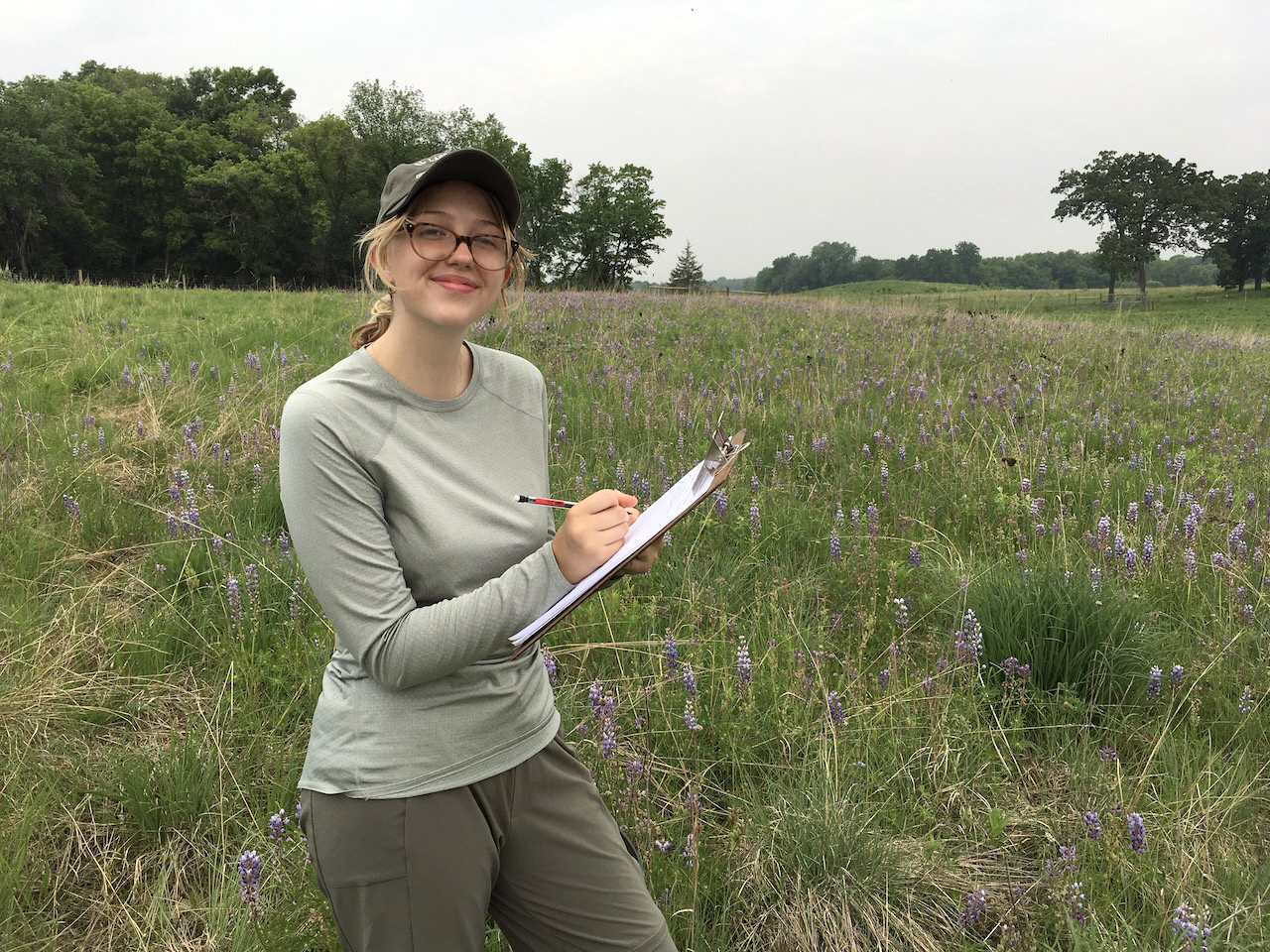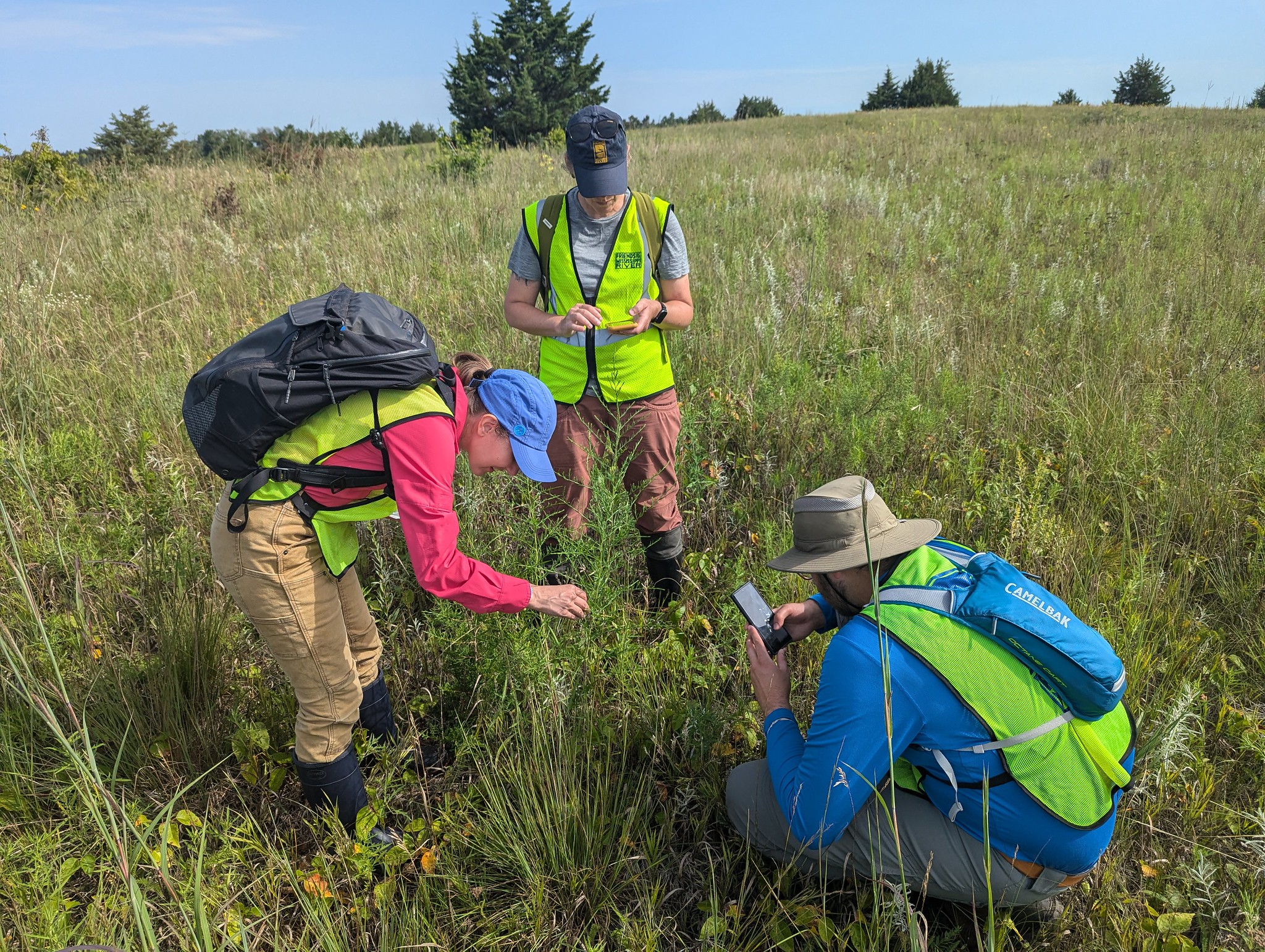Monitor monarchs with FMR's Pollinator Evaluation Program (PEP)

Pollinator monitors (like former intern Annika Brelsford, above) help FMR gauge our impact and refine our habitat restoration work.
If you're looking for an in-depth experience contributing to pollinator research and conservation, enjoy learning about insects and plants, and like to work independently (solo, as a couple or with family or friends), consider volunteering with our Pollinator Evaluation Program (PEP).
Since 2018, FMR has been monitoring pollinators at several restoration sites we manage. In 2025, we expanded our volunteer monitoring opportunities.
Would you like to join us?
Trained by an FMR ecologist, PEP volunteers learn to identify monarchs at key points in their lifespan (using protocols from Monarch Joint Venture’s Integrated Monarch Monitoring Program) and submit observations to help us assess the impact of our restoration efforts.
Volunteers are trained to monitor at three public restoration sites: William H. Houlton Conservation Area in Elk River, Vermillion River Linear Park in Hastings, and River Heights Park in Inver Grove Heights. Thanks to an enthusiastic response to this new program, these sites filled up quickly for 2025 and are no longer accepting applications for this year. If you'd like to be among the first to be notified about openings for 2026, please contact us at pep@fmr.org.
All volunteers accepted into the program will participate in two training sessions:
• a spring training and kick-off to learn the identification and monitoring protocols, and
• a separate in-field, hands-on orientation and practice session at their selected monitoring site.
Volunteers are assigned a specific plot to monitor from late May to September. Participants can choose to monitor adult monarchs every other week, monarch larvae every week, or both, and can expect to contribute 25 or more hours over the summer.
Volunteers can work independently, as part of a chosen team or family group, or request to be randomly paired with another volunteer. The lead volunteer in any group must be 18 or older.
No experience is necessary; all are welcome. However, potential monitors should seriously consider the tasks and hours involved before committing to this program. Space is limited, and we rely on volunteers to be active participants.
Read on to decide if this program would be a good fit for you or if you'd prefer to support monarchs in other ways (we'll offer some tips and resources).

FMR staff and former intern monitoring plants.
What to expect as a PEP volunteer
- Accessibility: Volunteers will spend time walking and bending over in full sun and off trails in tall vegetation. They are encouraged to wear long pants, closed-toe shoes, and sun protection. Volunteers will also spend time at a computer or tablet, entering and submitting their data into an online portal.
- Volunteers should expect to spend at least 25 hours on the program, including training, field monitoring, and data entry. Volunteers may choose to pair up and alternate weekly monitoring duties to reduce their time commitment.
- A professional pollinator biologist from FMR will lead the two required training sessions: A 1.5-hour kick-off introducing participants to monarch biology, identification, and monitoring protocols and a two-hour in-field training where participants are oriented to their assigned plot and can practice protocols and hands-on identification. Both sessions are required. (Dates will be updated annually and listed below.)
- No prep work is required, although optional reading materials and video tutorials will be shared with registered volunteers to support their participation. (You will be in the hands of excellent trainers who will teach you everything you need to know.)
- Participants will meet at the kick-off training and get to know one another at their chosen monitoring site during the field training.
- Volunteers will be grouped by site. FMR will add names and email addresses to a Google email group for each site to encourage discussion and information sharing. FMR's pollinator biologist will be a member of each group and available to answer questions throughout the monitoring season.
- Volunteers will monitor monarch larvae weekly and/or adults bi-weekly from late May through September. A monitoring session will take between half an hour and an hour, not including transportation time.
- During field surveys, volunteers will identify milkweed plants and monarchs at various life stages (egg, five larval instars, pupae, adult).
- Potential volunteers and/or registered participants are welcome to review the Integrated Monarch Monitoring Program (IMMP) training materials on the Monarch Joint Venture website for more in-depth descriptions of monitoring activities. Volunteers will use Activity 2: Monarch Egg and Larva Survey and/or Activity 3: Adult Monarch Survey protocols.
- FMR's pollinator biologist and ecologists will review data and complete reports in the fall and winter.
- Results from the monitoring season will inform how FMR manages restorations and contribute to the publicly accessible Monarch Joint Venture database, which scientists and conservation practitioners use to understand monarch population trends and improve conservation outcomes.
- All program participants will receive results annually in the winter. FMR may also share and promote findings on our website and in Mississippi Messages.
- All equipment and training materials will be provided, as well as refreshments during training sessions. We appreciate your time and commitment!
Questions?
If you have questions about the program or would like to be notified when applications open for 2026, please contact us at pep@fmr.org.
Other ways to help!
Not sure if you're ready to make this commitment? There are many other ways to support pollinators in the metro area.
- Join an FMR event to help plant or restore much-needed pollinator habitat.
- Support pollinators in your own backyard.
- Plant native species to protect water quality and provide pollinator habitat.